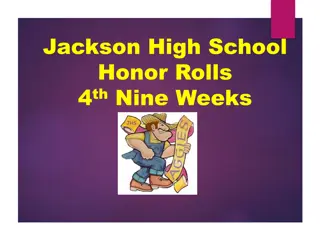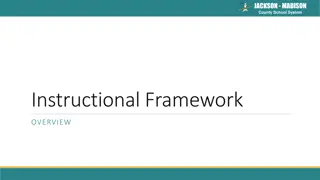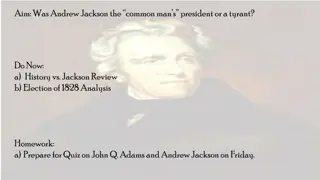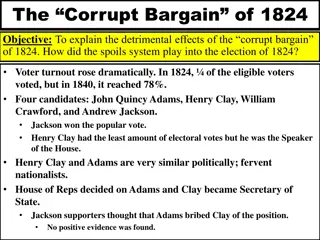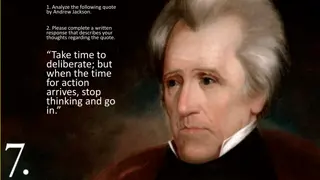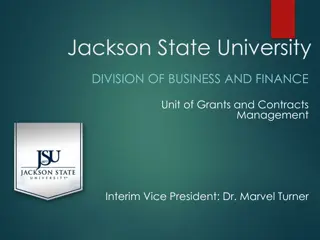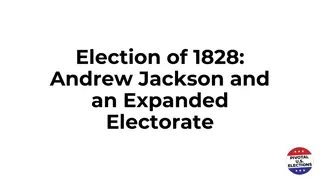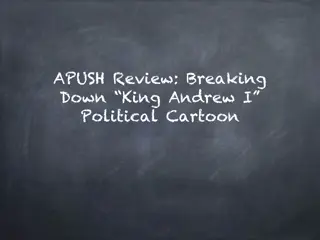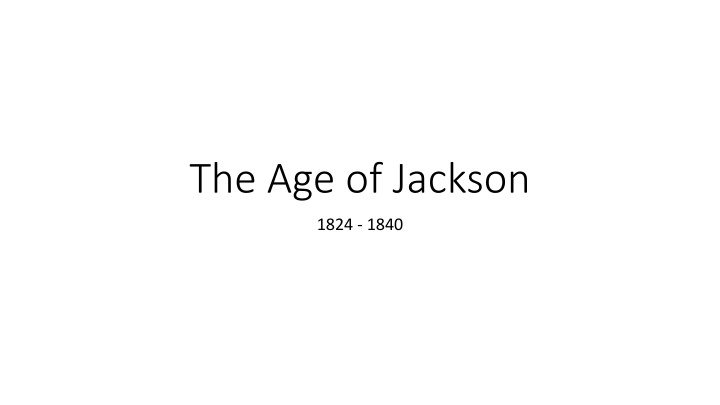
The Age of Jackson and the Evolution of American Politics
Discover the transformative era of Andrew Jackson's presidency from 1824 to 1840, highlighting the rise of political parties, the significance of mass politics, and the intense Election of 1828. Uncover the campaign dynamics, attacks, and the transition in political systems amidst a changing democratic landscape. Witness Jackson's victory and the coalitional approach adopted by the Democrats. Dive into the essence of democratic pride, party loyalty, and the spirit that shaped American politics during this era.
Download Presentation

Please find below an Image/Link to download the presentation.
The content on the website is provided AS IS for your information and personal use only. It may not be sold, licensed, or shared on other websites without obtaining consent from the author. If you encounter any issues during the download, it is possible that the publisher has removed the file from their server.
You are allowed to download the files provided on this website for personal or commercial use, subject to the condition that they are used lawfully. All files are the property of their respective owners.
The content on the website is provided AS IS for your information and personal use only. It may not be sold, licensed, or shared on other websites without obtaining consent from the author.
E N D
Presentation Transcript
The Age of Jackson 1824 - 1840
Importance of political parties The spirit that motivated mass politics was: democratic pride in participation The new politics placed great emphasis on party loyalty The average voter was encouraged to make a permanent commitment to a political party Political parties offered the same satisfaction that popular sports offer today - excitement, entertainment and a sense of belonging
The Election of 1828 Andrew Jackson was able to ride the wave of new democratic politics to the presidency, with the help of his campaign manager, Martin Van Buren. Jackson s party Democratic-Republicans became Democrats John Quincy Adams National Republican party Neither campaigned on his own it was considered undignified to do so instead supporters of both candidates campaigned vigorously, freely, and negatively
Campaign attacks Jackson s supporters portrayed the campaign as a contest between democracy of the country, on one hand, and a lordly, arrogant, aristocracy on the other Adams s supporters depicted Jackson as an illiterate backwoodsman, a murderer (he had killed several men in duels), and an adulterer (his wife Rachel was still married when they began dating)
The campaign John C. Calhoun Jackson s running mate for VP was John C. Calhoun (South Carolina) showed the transitional nature of politics at the time because Calhoun was also John Quincy Adams s VP That Calhoun was able to easily lend his support to a rival faction was a holdover from the old elite and personal politics that would soon be impossible in the new democratic political system
The win Jackson won 56% of the popular vote (well over 80% in much of the south and west) and a decisive electoral majority of 178 votes to Adams s 83. Popular appeal, which Jackson the military hero possessed, was not enough to ensure victory To be truly national a political party had to create and maintain a coalition of North, South, and West - the Democrats were the first to do this
The Jackson Presidency Jackson s election ushered in the age of the common man Jackson however, was no common man: he was a military hero, a rich slave owner, and a decidedly undemocratic personality The secret to Jackson s appeal was because of the changing nature of American society Jackson was the first to respond to the ways in which westward expansion and the extension of suffrage were changing politics at the national as well as local and state levels
Popular Opinion March 4, 1829 Andrew Jackson was inaugurated as president of the United States In the popular mind, his fierce belligerence came to symbolize pioneer independence Inauguration - Jackson was still mourning the loss of his wife Rachel, whose death he attributed to the slanders of the campaign Change in political tone During the inauguration people stood on chairs and sofas to catch glimpses of Jackson and shoved and pushed to reach food and drink. Their celebrating dismayed the city s more respectable citizens
The spoils system There was nothing wrong in the rule, that to the victor belong the spoils of the enemy. William Marcy The spoils system a practice of awarding government appointments to loyalists of the winning party This attitude toward public office was one of the main differences between the new politics and the old Jackson opened up all federal positions to party loyalists, and his opponents quickly found examples of corruption and inefficiency among new office holders
National leader vs. Sectional leader Despite his western origins, Jackson was a genuinely national figure He was more interested in asserting strong national leadership than promoting sectional compromise Jackson believed that the president (who symbolized the popular will of the people) ought to dominate the government Jackson dominated his administration. He mostly ignored heads of government departments who made up his official cabinet He instead consulted with an informal group made up of Van Buren (Secretary of State) and old western friends. They were called his Kitchen Cabinet.
Indian Removal Indian removal clearly showed how unfair majority rule could be when the minority was not strong enough to force a compromise The official policy of the US government from the time of Jefferson was to promote the assimilation of Indian peoples by encouraging them to adopt white ways To native American groups that resisted assimilation, Jefferson s alternative was removal from settled areas in the east to new Indian Territory west of the Mississippi River At the end of the war of 1812 the federal government signed removal treaties with a number of native American nations opening up large tracts of land for white settlement
Native American Tribes In the Southwest, 5 tribes remained: The Five Civilized Tribes The Cherokees, Chickasaws, Choctaws, Creeks and Seminoles Under constant pressure from white settlers, most ceded their lands, some decided to co-exist through assimilation
The Cherokee They took the most extensive steps to adopt white ways Their tribal lands in northwestern Georgia had prosperous farms, businesses, grain and lumber mills, and even plantations with black slaves Intermarriage with whites and African Americans produced an influential group of mixed race offspring within the Cherokee nation They took special pride in their alphabet for their own language that was developed by the Cherokee scholar, Sequoyah In 1828 they began publishing a tribal newspaper, The Cherokee Phoenix, in both Cherokee and English
Cherokee continued Despite the evidence of the Cherokee s successful assimilation, their removal was still imminent Responding to pressures from land-hungry whites, in the 1820s, the legislatures of Georgia, Alabama, and Mississippi, voted to invalidate federal treaties that granted special self-governing status to Indian lands The Federal government, not the states, were responsible for Indian policy therefore the state actions constituted a major sectional challenge to federal authority In this instance (unlike the Nullification Crisis) the states had the support of the President
Jackson and Indian Removal In 1830, at President Jackson s request, US Congress passed the Indian Removal Act which appropriated funds for relocation, by force if necessary Jackson increased the pressure by sending federal officials to negotiate with native tribes most reluctantly signed and moved The Cherokee used the white man s weapon the law Cherokee Nation v. Georgia (1831) and Worcester v. Georgia (1832) Chief Justice John Marshall ruled that the Cherokees, though not a state or a foreign nation, they were a domestic dependent nation that could not be forced by the state of Georgia to give up its land against its will
Pres. Jackson and Indian Removal continued.. When Jackson heard of the Supreme Courts decision he responded: John Marshall has made his decision. Now let him enforce it. President Jackson ignored the court s decision and continued his support of removal Resisting Cherokees were driven west to Oklahoma along what became know as the Trail of Tears The Trail of Tears A 7,000 man US army escorted thousands of native Americans west and watched a quarter or 16,000 Cherokee die along the way
Native American Resistance Some Seminole Indians in Florida chose to fight (Osceola) Aided by runaway slaves and by their knowledge of the Florida Everglades, some Seminole groups fought a war that lasted into the 1840s before the US military gave up and allowed them to remain
Conclusion Indian removal was a deeply divisive national issue President Jackson s policy expressed the opinion of most Southerners and Westerners However, Northern opinion, led by religious groups, strongly opposed the Removal Act Jackson s presidential claim to speak for popular opinion was running into increasing opposition
The Nullification Crisis What was the correct balance between local interests (the rights of states) and the powers of the central government? The political issue that came to symbolize the different sectional interests of North and South, pitting the rights of individual states against the claims of a federal majority was the protective tariff Tariff a tax on foreign imported goods Wealthy southern planters were opposed to tariffs because tariffs raised the cost of luxury goods they imported from Europe (tariffs made the items that they purchased from overseas more expensive). Southerners also feared that American tariffs would cause other countries to retaliate with tariffs against southern cotton (adding a tax on cotton would make it more expensive for others to purchase).
Tariffs continued.. Tariffs 1816, 1824, 1828 and 1832 Most southern congressmen thought that the 1816 tariff was a temporary post-war recovery (to help boost the economy), so they voted for it, but it was not temporary As the north industrialized and new industries demanded protection by the government, tariff bills in 1824 and 1828 raised tax rates higher Southerners protested They were out voted in congress by northern and western representatives What does it mean to need protection as a business how do tariffs help? (refer to chapter 12 p. 364)
Tariffs continued.. 1828 Tariff of abominations imposed especially high tariffs on imported textiles and iron Southern opponents to the tariff insisted that it was not a truly national measure, but a sectional one that only helped some groups/states while harming others Southern states considered the increased tariffs unconstitutional because they violated the rights of some states South Carolina reacted the most forcefully to the tariff of abominations
South Carolina Economic Fears Of the older southern states, South Carolina was the hardest hit by the opening of the new cotton lands in the Southwest, which drained both population and commerce from the state By 1800 Charleston (S. Carolina s capitol) was still an important seaport, but by 1820s it was eclipsed by major northern ports - along with Mobile and New Orleans (major ports for exporting cotton) Lastly, there were real fears about national attitudes towards slavery The British were planning to emancipate all of the slaves in the British Caribbean islands S. Carolina feared that if congress had the right to impose tariffs that were harmful to some southern states - nothing would prevent it from enacting legislation like Britain s - depriving southerners also of their slaves (their livelihood) Another example of federal vs. states rights
Doctrine of Nullification The result of these fears was a renewed interest in the doctrine of nullification The doctrine of nullification upheld the right of a state to declare a federal law null and void and to refuse to enforce it within the state At issue was the power of the state against that of the federal government John C. Calhoun supported nullification and as the VP to Andrew Jackson, he believed he could sway the president s opinion He could not.
John C. Calhoun Where Calhoun saw nullification as a protection of the rights of the minority, Andrew Jackson saw it as a threat to national unity The president and the vice president were thus in open disagreement on a matter of crucial national importance Calhoun lost all influence with Jackson Two years later Calhoun resigned as VP and became a senator in South Carolina. Martin van Buren was elected as VP By 1832 nullification became a full blown crisis
Nullification continued.. In passing the Tariff of 1832, Congress retained high taxes on woolens, iron and hemp, although it reduced duties on other items South Carolina responded with an Ordinance of Nullification in which it rejected the tariff and refused to collect the taxes it required The state further issued a call for a volunteer militia and threatened to secede from the Union if Jackson used force against it
Jacksons response to nullification Jackson responded with anger and force: Disunion by armed force is treason Jackson obtained from congress a Force Bill authorizing the federal government to collect the tariff in South Carolina at gunpoint if necessary With the support of Calhoun Henry Clay drafted a compromise the Tariff act of 1833 The Tariff Act of 1833 appeared to meet southern demands by pledging a return to the tariff rate of 1816 (a smaller tax rate) by 1842 through a series of very small annual (yearly) decreases for nine years followed by a large cut in the final year (1842)
Nullification repealed In 1833 the South Carolina legislature, unwilling to act without the support of other southern states, quickly accepted this face-saving compromise and repealed its nullification of the tariff of 1832
Conclusion The nullification crisis was the most serious threat to national unity that the United States had ever experienced at that time (even compared to The Missouri Compromise and Indian removal) South Carolinians by threatening to secede, had forced concessions on a matter they believed of vital economic importance to their state Most Americans firmly believed that although every effort should be made to address sectional (state) concerns, national unity and majority rule came first
The Bank War The last major event of Jackson s presidency - his refusal to renew the charter of the Second Bank of the United States - had lasting political consequences Background information: The last major event of Jackson s presidency was his refusal to renew the charter of the Second Bank of the US The First Bank of the US was chartered by Congress in 1791, at Alexander Hamilton s urging (Federalists wanted a national bank) Federalists supported it, Jeffersonians (Democratic-Republicans) opposed it and allowed the charter to expire in 1811 After the War of 1812, Congress granted a 21 year charter to the Second Bank of the US
History of the National Bank The Bank played a powerful role in the expanding American economy, encouraging the growth of strong and stable financial interests and curbing less stable and irresponsible ones Like the 1stbank, the 2ndbank was not a government agency, but a private institution The stockholders to the bank were some of the nation s wealthiest men The bank was directed by the aristocratic Nicholas Biddle of Philadelphia
Functions of the Bank What exactly did the bank do? Held the government s money (about $10 million) Made commercial loans It s most important function was it exercised control over state banks During this period America did not have a national currency (it was a mixture of paper money (US notes and the notes of state banks) gold and silver coins
Functions of the bank continued.. State banks tended to issue more paper money than they could back with hard currency so state banks had to pay back loans to the national bank in coins This policy ensured that state banks had enough money in its reserves and avoided inflation (over printing of bank notes) The national Bank acted as a currency stabilizer by helping to control the money supply It brought a semblance of order to what was a chaotic money system
Opponents to the Bank The concept of a strong national bank was supported by the majority of the nations merchants and businessmen but it also had many opponents The opponents of the bank came from both sectional and political resentments A number of state bank directors felt overshadowed by the central bank s size and power To some the economic power of the Bank was frightening they feared that elites would use it to their own advantage They believed that a system based on paper currency would be manipulated by bankers in unpredictable and dangerous ways
Bank Vetoed Biddle urged by Henry Clay and Daniel Webster made an early application for the re-chartering of the Bank Congress approved the application in July 1832 Clay and Webster, aware of Jackson s anti-bank feelings, did not think he would risk a veto during an election year (they were wrong) Jackson immediately vetoed the Bank charter Jackson viewed the bank as unconstitutional, harmful to states rights, and dangerous to the liberties of the people.
Jackson vs. The National Bank The veto spoke directly to many of the fears and resentments that Americans felt at this time of exceptionally rapid economic and social change Jackson presented himself as the spokesman for the majority of ordinary people and the enemy of special privilege he believe that the banks special privileges benefitted only the rich Jackson claimed to speak for the humble members of society the farmers, mechanics and laborers
Jackson re-elected in 1832 The Bank charter did not expire until 1836, but Jackson decided to kill the Bank early by transferring its $10 million in government deposits to favored state banks pet banks Cabinet members objected, but Jackson ignored them two secretaries of the treasury refused to carry out Jackson s orders and were removed from their jobs Jackson responded to all of this that the election had given him a popular mandate to act against the Bank: The president was the direct representative of the people and could act upon the popular will, regardless of the opinion of congress or even the cabinet
Nicholas Biddle This worthy President thinks that because he has scalped Indians he is to have his way with the Bank. He is mistaken Nicholas Biddle (President of the National Bank) So what did Biddle do? Biddle called in all bank loans causing a sharp panic and recession in the winter of 1833 34 Merchants, businessmen, and southern planters were all furious at Jackson Jackson s opponents who were only a small group at this time joined together into a formal opposition party (The Whig Party refer to Chapter 12 Sec 4 Assessment and class notes)
The Panic of 1837 A Perfect Storm The consequences of the Bank War continued Backed by foreign investors (especially British), many new state banks were chartered and were eager to give loans The price of cotton rose along with the desire to purchase western lands (inflation prices go up, value of money goes down) Jackson was concerned at the use of paper money and announced that the government would only accept payment for public loans in hard currency At the same time, foreign investors, especially the British banks, began to deal with a world recession and called in their American loans This sharp contraction of credit led to the Panic of 1837 and a 6-year recession, the worst the American economy had yet known
3 more slides 3 more slides Ironically, Andrew Jackson, whose bad experience with speculation had led him to destroy the Bank of United States, set in motion the events that caused the economic boom and bust that he feared The collapse of the banking system led to business closures and outright failures (Martin van Buren becomes President in the midst of the financial crisis and is blamed) In the winter of 1837-38 in New York city alone, one-third of all manual laborers were unemployed and an estimated 10,000 were living in abject poverty The panic of 1837 lasted six long years, causing widespread misery. Not until 1843 did the economy show signs of recovery
2ndto last slide Unlike in modern times In 1837 the federal government did not take any action to aid victims of the economic recession banks were not bailed out, no laid off workers got unemployment payments All of these steps, today seen as essential to prevent economic collapse and alleviate human suffering were unheard of in 1819 and 1837 As a result, workers, farmers, and members of the new business middle class realized that participation in America s booming economy was very dangerous the rewards could be great, but so could the penalties
Conclusion Conclusion Andrew Jackson s presidency witnessed the building of a strong national party system based on nearly universal white manhood suffrage At the same time the nation expanded politically (nine new western states were admitted between 1800 and 1840) Construction of new roads, canals, railroads and other improvements in transportation and communication, created the infrastructure that united the nation physically As the key battles of the Jackson Administration showed (The Nullification Crisis, Indian Removal, The Bank War) the forces of sectionalism resisted the strong nationalizing tendencies of the era In the future we will explore how economic and social forces continued to force the South and North apart







